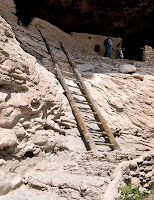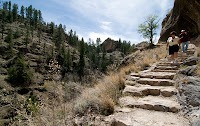 A distance of 72 miles in New Mexico means a huge change in the scenery. On Saturday, John, Cookie, and I started in Deming and drove north. We began in flat desert country; drove through rolling hills that were brown, dry, and covered in sage and cactus; passed through increasingly green terrain and large pine trees; and ended up in a low mountain range where the road narrowed, the center line disappeared, and hairpin turns and switchbacks became the norm. The view on one side was the cut in the hillside where rocks and trees were poised to fall without warning -- and one big rock in the road proved that they do, indeed, fall. The view on the other was a steep slope into a wide valley, only a flimsy guardrail and the car's brakes between us and a plunge to the bottom.
A distance of 72 miles in New Mexico means a huge change in the scenery. On Saturday, John, Cookie, and I started in Deming and drove north. We began in flat desert country; drove through rolling hills that were brown, dry, and covered in sage and cactus; passed through increasingly green terrain and large pine trees; and ended up in a low mountain range where the road narrowed, the center line disappeared, and hairpin turns and switchbacks became the norm. The view on one side was the cut in the hillside where rocks and trees were poised to fall without warning -- and one big rock in the road proved that they do, indeed, fall. The view on the other was a steep slope into a wide valley, only a flimsy guardrail and the car's brakes between us and a plunge to the bottom.
Our destination was the Gila Cliff Dwellings, part of the Gila National Forest. While this area has been occupied for thousands of years, for a short period of time humans built dwellings within the natural cliffs that overlook the Gila River. A small subgroup of people of the Mogollon (mo-go-yon) culture, probable relatives of the Zuni and Hopi, lived here from 1270 to 1300, and then moved on for reasons unknown.
 We arrived at the park, stopped for shopping and a bathroom break at the Visitor Center, and then began the short hike up to the cliffs. The trail was a 1-mile loop, following a lower path up to the cliffs and returning by a higher path that descended just before the trailhead. Once we had climbed the 180 feet to the level of the cliffs, we got our first good view of the actual dwellings. They can be seen in the center of this photo.
We arrived at the park, stopped for shopping and a bathroom break at the Visitor Center, and then began the short hike up to the cliffs. The trail was a 1-mile loop, following a lower path up to the cliffs and returning by a higher path that descended just before the trailhead. Once we had climbed the 180 feet to the level of the cliffs, we got our first good view of the actual dwellings. They can be seen in the center of this photo.
 There are six dwellings, side by side, on this cliff. The ones used as residences were not open to the public, but we were able to climb into, and walk through the largest one, a ceremonial area dominated by a huge kiva. The rest of the cave was divided into several smaller rooms, some of which appeared to have been used for food preparation. The inhabitants cultivated crops, primarily corn, beans and squash, and hunted game. One room still had very tiny ears of corn, the actual size of the mature crop, littering the floor.
There are six dwellings, side by side, on this cliff. The ones used as residences were not open to the public, but we were able to climb into, and walk through the largest one, a ceremonial area dominated by a huge kiva. The rest of the cave was divided into several smaller rooms, some of which appeared to have been used for food preparation. The inhabitants cultivated crops, primarily corn, beans and squash, and hunted game. One room still had very tiny ears of corn, the actual size of the mature crop, littering the floor.
 There were two drawings on the walls. One was this red painting of the figure of a person. The other was a hand print. These simple little expressions of 700-year old graffiti artist make a human to human connection like nothing else can. You have to wonder about the person who stood here, hundreds of years ago, and put his or her hand print on the wall or sketched a little stick figure. Was it meaningful? Or were they just doodling out of boredom? Was it "naughty" or "nice" to scribble on the walls?
There were two drawings on the walls. One was this red painting of the figure of a person. The other was a hand print. These simple little expressions of 700-year old graffiti artist make a human to human connection like nothing else can. You have to wonder about the person who stood here, hundreds of years ago, and put his or her hand print on the wall or sketched a little stick figure. Was it meaningful? Or were they just doodling out of boredom? Was it "naughty" or "nice" to scribble on the walls?
 The descent from the dwelling involved coming down a large wooden ladder, much the way the original inhabitants entered and left. Visitors with vertigo or those otherwise nervous about coming down the ladder could exit using the entrance stairs. I went down a few steps carved in the rock and took the ladder. Although it looked a bit daunting from the top, once my feet were firmly on the rungs it was an easy descent.
The descent from the dwelling involved coming down a large wooden ladder, much the way the original inhabitants entered and left. Visitors with vertigo or those otherwise nervous about coming down the ladder could exit using the entrance stairs. I went down a few steps carved in the rock and took the ladder. Although it looked a bit daunting from the top, once my feet were firmly on the rungs it was an easy descent.
 The hike back began with downhill steps cut into the rock, but soon became a dirt path with several switchbacks. Once we got down, we chatted with a volunteer ranger (who was also an RVer) for a while, and then took a different, but no less scenic way home, stopping for home-made ice cream on the way. It was a long day, but the beautiful scenery and the fascinating story of the cliff dwellers made it all worth while.
The hike back began with downhill steps cut into the rock, but soon became a dirt path with several switchbacks. Once we got down, we chatted with a volunteer ranger (who was also an RVer) for a while, and then took a different, but no less scenic way home, stopping for home-made ice cream on the way. It was a long day, but the beautiful scenery and the fascinating story of the cliff dwellers made it all worth while.

2 comments:
I missed something along the way. Who is John Cookie?
Nancy
John and Cookie are two RVing friends -- see http://obsirius.blogspot.com/2008/04/my-first-visit-to-mexico.html for a photo.
ZoAnn
Post a Comment